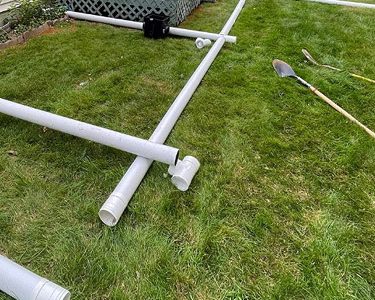Loudonville Drainage & Erosion Control
Peak will work with you to determine the most effective strategies for eliminating water in areas where you don’t want it.

Types of Drainage Systems
Dry Wells
A dry well drain, also known as a dry well system or dry well installation, is a drainage method used to manage excessive water runoff or surface water in a controlled manner. It is designed to collect and disperse water into the ground, preventing pooling, flooding, and erosion.
A typical dry well drain consists of a large underground pit or chamber that is filled with gravel or crushed stone. This pit allows water to infiltrate into the surrounding soil gradually. The size of the dry well and the amount of gravel used depend on the expected volume of water to be handled. The dry well is usually covered with a grate or lid to prevent debris from entering and to provide access for maintenance.
When rainwater or other runoff enters the dry well, it percolates through the gravel or crushed stone, allowing it to gradually disperse into the soil. The surrounding soil acts as a natural filter, helping to remove impurities and contaminants from the water before it reaches the groundwater table.
Dry wells are commonly used in areas with poor natural drainage or in situations where traditional stormwater management systems are not feasible. They are effective in redirecting water away from structures, low-lying areas, or areas prone to water accumulation. Dry wells are frequently employed in residential, commercial, and municipal settings to mitigate stormwater runoff and prevent flooding.
Proper installation and maintenance of dry wells are essential to ensure their optimal performance. Regular inspection, cleaning, and removal of accumulated sediment or debris are necessary to prevent clogging and maintain the functionality of the system.
Do you have a drainage problem on your property?
Common fixes include grading and sloping to eliminate water build-up near your home or near other structures. Peak will work with you to determine the most effective strategies for eliminating water in areas where you don’t want it. Hardscape materials, site drainage, and creative landscape design strategies like porous pavements and dry river beds can all aid in mitigating standing water and improving yard drainage.
French Drains
A French drain is a type of drainage system designed to redirect and manage excess water in the soil. It consists of a trench filled with gravel or rock and a perforated pipe, which is then covered with more gravel or rock. The purpose of a French drain is to create a path of least resistance for water to flow away from an area that experiences drainage issues, such as water pooling, soggy soil, or basement flooding.
When water encounters the French drain, it seeps through the gravel or rock and enters the perforated pipe. The pipe then carries the water away from the problem area, allowing it to disperse safely elsewhere, such as a designated drainage area or a municipal stormwater system. The French drain effectively prevents water accumulation, reducing the risk of water damage to buildings or landscaping.
French drains are commonly used in situations where surface water needs to be redirected, such as around foundations, along slopes, or in low-lying areas prone to waterlogging. They can be installed horizontally or vertically depending on the specific drainage needs. Proper installation and maintenance of French drains are important to ensure their effectiveness and longevity in managing water drainage concerns.
Request A Free Quote Here
Fill Out The Form Below
"*" indicates required fields
Leader Drains (From Roof Gutter)
Leader drains, also known as downspouts or gutter downpipes, are components of a building’s rainwater drainage system. They are vertical pipes or tubes that collect and direct rainwater from the gutters or eaves of a structure to a designated drainage area or underground drainage system.
Leader drains play a crucial role in preventing water damage to the building’s foundation, walls, and landscaping by efficiently channeling rainwater away from the structure. They typically connect to the horizontal gutters at various points along the roofline and extend downward to the ground or a designated drainage system.
Leader drains are often made of materials such as PVC (polyvinyl chloride), aluminum, or galvanized steel. They may come in various shapes and sizes, depending on the specific requirements of the building and local building codes.
To ensure proper functioning, leader drains are typically equipped with components such as elbows, downspout brackets, and extensions. Elbows allow for changes in direction, ensuring that the rainwater is directed away from the building and towards the desired drainage area. Downspout brackets secure the downspout to the building’s exterior, providing stability and preventing damage from wind or other external factors. Extensions can be added to the downspout to redirect water farther away from the building’s foundation or to direct it into an underground drainage system.
Regular maintenance and cleaning of leader drains are essential to prevent clogs caused by debris, leaves, or other obstructions. Clogged or improperly functioning leader drains can lead to water backup, overflowing gutters, and potential water damage to the building. Therefore, it is important to inspect and maintain leader drains regularly to ensure effective rainwater management and the protection of the building’s integrity.
Water Features
Water features are decorative elements that incorporate water to enhance the aesthetics and ambiance of indoor or outdoor spaces. They come in various forms, sizes, and styles, offering a soothing and captivating visual display while adding a sense of tranquility to the environment.
Some common types of water features include:
Fountains: Fountains are perhaps the most recognizable water feature. They typically consist of a central spout or multiple jets that propel water into the air, creating a beautiful display of falling water. Fountains can range from small tabletop versions to large, grand installations in public spaces.
Waterfalls: Waterfalls simulate the natural cascading flow of water. They can be designed to create a serene and calming atmosphere, whether incorporated into a pond, rock formation, or standalone structure.
Ponds and Lakes: Ponds and lakes are larger water features that provide a habitat for aquatic plants, fish, and other wildlife. They can be natural or man-made and often serve as focal points in gardens or outdoor landscapes.
Streams and Creeks: These water features involve the controlled flow of water along a channel, creating a dynamic and lively element in the landscape. They can be integrated into gardens or outdoor spaces to mimic the meandering path of a natural stream.
Water Walls: Water walls are vertical structures where water flows down a flat surface, often made of glass, stone, or metal. They provide a sleek and modern design element, creating a visually striking display.
Water features can be customized to suit various settings, including residential gardens, public parks, commercial spaces, or even indoor environments. They offer not only aesthetic appeal but also the calming sound of running water, which can help create a serene and relaxing atmosphere. Additionally, water features can help improve air quality by adding moisture and acting as a natural humidifier.
When planning to install a water feature, considerations such as water source, circulation system, maintenance requirements, and safety measures should be taken into account. Proper installation, regular maintenance, and appropriate water treatment are essential to ensure the longevity and cleanliness of the water feature.
Cisterns and rainwater storage
Cisterns and rainwater storage systems are designed to collect and store rainwater for various purposes, such as irrigation, non-potable water use, or even drinking water in certain cases. They provide a sustainable and efficient means of utilizing rainwater while reducing reliance on traditional water sources.
A cistern is a large container or underground reservoir specifically designed to store and hold rainwater. It can be made from various materials, including concrete, plastic, or metal, and comes in different sizes to accommodate the desired water storage capacity. Cisterns are often equipped with filters, screens, and covers to prevent debris, insects, or contaminants from entering the system.
Rainwater storage systems can be above-ground or underground, depending on space availability and preferences. Above-ground storage tanks are visible and easily accessible for maintenance, while underground cisterns are concealed and can save space. Both systems can be connected to the building’s gutters and downspouts to collect rainwater efficiently.
The collected rainwater can be used for a variety of purposes, including watering gardens, lawns, or crops, flushing toilets, washing cars, or even supplying non-potable water for various industrial or commercial processes. With proper filtration and treatment, rainwater can also be used as a source of potable water in some regions.
Rainwater storage systems offer several benefits, including water conservation, cost savings, and reduced strain on municipal water supplies. They help reduce stormwater runoff, which can contribute to flooding and erosion, by capturing and storing rainwater on-site. Moreover, rainwater is generally free of chlorine and other chemicals found in tap water, making it beneficial for plants and gardens.
It is important to consider local regulations, system design, maintenance, and water quality factors when implementing a rainwater storage system. Regular maintenance, including cleaning filters and screens, inspecting the cistern for leaks or damage, and treating the water if used for potable purposes, ensures the longevity and effectiveness of the system.
